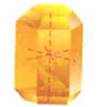
(a)
To sketch the cross section from a horizontal slice of a tetragonal crystal and to describe the rotational symmetry.
(a)
Answer to Problem 28PPS
The cross section from a horizontal slice of a tetragonal crystal gives a square.
Explanation of Solution
Given Information:
A picture of tetragonal crystal is shown below:

Formula Used:
Rotational Symmetry: A shape has rotational symmetry when it still looks the same after some rotations. The number of positions in which a figure can be rotated and still appears exactly as it did before the rotation is called order of symmetry. The
A cross section from a horizontal slice of a tetragonal crystal gives square
A square has 90 and 180 degree rotational symmetry.
Order of symmetry = 4
(b)
To sketch the cross section from a horizontal slice of a hexagonal crystal and to describe the rotational symmetry.
(b)
Answer to Problem 28PPS
The cross section from a horizontal slice of a hexagonal crystal gives a regular hexagon.
Explanation of Solution
Given Information:
A picture of hexagonal crystal is shown below:

Formula Used:
Rotational Symmetry: A shape has rotational symmetry when it still looks the same after some rotations. The number of positions in which a figure can be rotated and still appears exactly as it did before the rotation is called order of symmetry. The angle of turning during rotation is called angle of rotation.
A cross section from a horizontal slice of a hexagonal crystal gives a regular hexagon
A regular hexagon has 60, 120 and 180 degree rotational symmetry.
Order of symmetry = 6
(c)
To sketch a cross section from a horizontal slice of a monoclinic crystal and to describe the rotational symmetry
(c)
Answer to Problem 28PPS
The cross section from a horizontal slice of a monoclinic crystal gives a rectangle.
Explanation of Solution
Given Information:
A picture of monoclinic crystal is shown below:

Formula Used:
Rotational Symmetry: A shape has rotational symmetry when it still looks the same after some rotations. The number of positions in which a figure can be rotated and still appears exactly as it did before the rotation is called order of symmetry. The angle of turning during rotation is called angle of rotation.
A cross section from a horizontal slice of a monoclinic crystal gives a rectangle.
A rectangle has 180 degree rotational symmetry.
Order of symmetry = 2
Chapter 12 Solutions
Glencoe Geometry
Additional Math Textbook Solutions
Calculus: Early Transcendentals (2nd Edition)
Thinking Mathematically (6th Edition)
Intro Stats, Books a la Carte Edition (5th Edition)
A Problem Solving Approach To Mathematics For Elementary School Teachers (13th Edition)
Pre-Algebra Student Edition
Elementary Statistics (13th Edition)
- Decomposition geometry: Mary is making a decorative yard space with dimensions as shaded in green (ΔOAB).Mary would like to cover the yard space with artificial turf (plastic grass-like rug). Mary reasoned that she could draw a rectangle around the figure so that the point O was at a vertex of the rectangle and that points A and B were on sides of the rectangle. Then she reasoned that the three smaller triangles resulting could be subtracted from the area of the rectangle. Mary determined that she would need 28 square meters of artificial turf to cover the green shaded yard space pictured exactly.arrow_forward7. 11 m 12.7 m 14 m S V=B₁+ B2(h) 9.5 m 16 m h+s 2 na 62-19 = 37 +, M h² = Bu-29arrow_forwardwhat would a of a interscribed angle be with an arc of 93 degrees and inside abgles of 111 and 98arrow_forward
- 6arrow_forwardDoor 87.5in to 47 living 44.75 Closet 96in Window ISS.Sin 48in Train Table 96in 48in 132:2 Windowarrow_forward39 Two sides of one triangle are congruent to two sides of a second triangle, and the included angles are supplementary. The area of one triangle is 41. Can the area of the second triangle be found?arrow_forward
 Elementary Geometry For College Students, 7eGeometryISBN:9781337614085Author:Alexander, Daniel C.; Koeberlein, Geralyn M.Publisher:Cengage,
Elementary Geometry For College Students, 7eGeometryISBN:9781337614085Author:Alexander, Daniel C.; Koeberlein, Geralyn M.Publisher:Cengage, Elementary Geometry for College StudentsGeometryISBN:9781285195698Author:Daniel C. Alexander, Geralyn M. KoeberleinPublisher:Cengage Learning
Elementary Geometry for College StudentsGeometryISBN:9781285195698Author:Daniel C. Alexander, Geralyn M. KoeberleinPublisher:Cengage Learning

